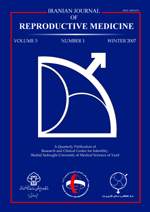
|
International Journal of Reproductive BioMedicine
Research and Clinical Center for Infertility, Shahid Sadoughi University of Medical Sciences of Yazd
ISSN: 1680-6433
EISSN: 1680-6433
Vol. 16, No. 8, 2018, pp. 535-540
|
 Bioline Code: rm18064
Bioline Code: rm18064
Full paper language: English
Document type: Short Communication
Document available free of charge
|
|
|
International Journal of Reproductive BioMedicine, Vol. 16, No. 8, 2018, pp. 535-540
| en |
Comparison of pre-treatment with OCPs or estradiol valerate vs. no pre-treatment prior to GnRH antagonist used for IVF cycles: An RCT
Nejad, Ensieh Shahrokh Tehrani; Ghaleh, Fatemeh Bakhtiari; Eslami, Bita; Haghollahi, Fedyeh; Bagheri, Maryam & Masoumi, Masoumeh
Abstract
Background: Both oral contraceptive pills (OCPs) and estradiol valerate (E2) have
been used to schedule a gonadotropin-releasing hormone antagonist in vitro
fertilization (IVF) cycles. Since the suppression of follicle-stimulating hormone by
OCPs can stay 5-7 days after stopping the pills, it seems that starting the
gonadotropin-releasing hormone (GnRH) after 6 days of pre-treatment
discontinuation may be important in IVF outcomes.
Objective: The aim of the present study was to determine the number of mature
oocyte and pregnancy rate of three pretreatment methods for fresh embryo transfer
cycles.
Materials and Methods: In this randomized controlled trial, two-hundred ten
women (18-35 yr and less than 2 previous IVF attempts) undergoing IVF with the
GnRH antagonist protocol were randomized to the OCP, E2, and no pretreatment
arms. OCP group (n=53) received OCP (ethinyl estradiol30 μg and
levonorgestrel150 μg), E2 group (n=63) received 4 mg/day oral E2 (17β‐E2) for 10
days from day 20 of the previous cycle and GnRH antagonist stimulation was started
6 days after the interruption of OCP and E2. The control group (n =70) did not
receive any pretreatment.
Results: No significant difference was observed in the mean number of the mature
oocyte, endometrial thickness, and embryo quality. The pregnancy rate in E2 group
was higher than the two other groups (42.9% vs 39.6% and 34.3% in OCP and
control group, respectively), but the difference was not statistically significant
(p=0.59).
Conclusion: It seems OCP or E2 pretreatment could not improve the fresh IVF-embryo
transfer outcomes.
Keywords
IVF; GnRH antagonist; Oral contraceptives; Estradiol.
|
| |
© Copyright 2018 - International Journal of Reproductive BioMedicine
Alternative site location: http://www.ijrm.ir
|
|
